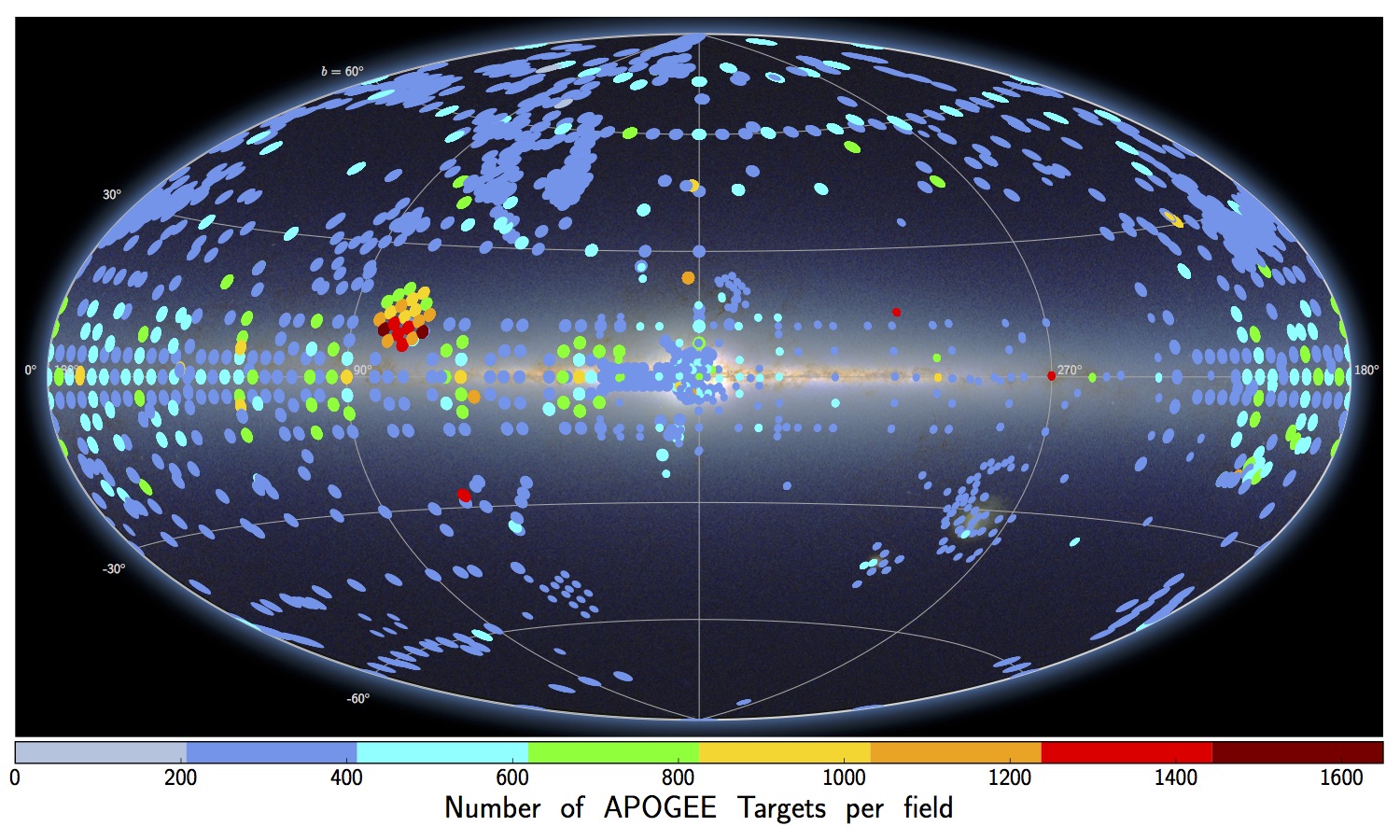APOGEE DR16 Synopsis
Data Release 16 provides reduced, visit-combined spectra as well as pipeline-derived stellar atmospheric parameters and individual elemental abundances for more than 430,000 stars, sampling all major components of the Milky Way.
DR16 Scope
DR16 contains 430,000 unique APOGEE targets in 1442 fields obtained in 1,800,000 individual visits. All data obtained through August 2018 is included. DR16 is the first data release to include data from APOGEE-2S, which began full operations in April 2017.
For all targets, DR16 provides visit spectra, heliocentric radial velocities, combined spectra, stellar atmospheric parameters (Teff, log g, vmicro, [M/H], [C/M], [N/M], [α/M], vsini/vmacro), and abundance determination for up to 26 species (C, C I, N, O, Na, Mg, Al, Si, P, S, K, Ca, Ti, Ti II, V, Cr, Mn, Fe, Co, Ni, Cu, Ge, Rb, Ce, Nd, and Yb).
Instructions on how to access the data can be found here. Five Value Added Catalogs have been provided with DR16 to enhance these products.
DR16 Observations
DR16 APOGEE Targets
DR16 contains data for approximately 430,000 unique APOGEE targets in 1442 fields, of which roughly 300,000 are main survey targets. A total of 1,800,000 individual visits are included in DR16. A general breakdown of targets in DR16-associated programs follows below:
34,000 targets toward the Bulge
57,600 targets toward the Halo
- 9,000 targets toward Halo streams
- 48,000 targets toward the smooth Halo
89,000 targets co-observed on MaNGA plates
128,000 targets toward the Disk
11,200 targets toward dwarf Satellite Galaxies
- 7,000 targets toward the Large and Small Magellanic Clouds
- 2,600 targets toward the the Sgr Core and Stream
- 1,600 targets toward dwarf Spheroidal satellites
28,000 targets toward Star Clusters
- 9,000 targets toward Young Clusters
- 19,000 targets toward Open or Globular Clusters
72,000 targets for Photometric Objects of Interest (POIs) in the Kepler, K2, CoRoT, and TESS footprints
13,000 targets in Ancillary Programs
35,000 targets in Contributed Programs
1,000 targets in NMSU 1-meter Programs
The Using Targets/Samples page provides guidance for identifying these target categories, while the target selection algorithms are described in the Targeting Information page. We anticipate two papers, F. Santana et al. (in prep.) and R. Beaton et al. (in prep.), will summarize the final targeting algorithms for APOGEE-2S and APOGEE-2N, respectively.
DR16 Sky Coverage
The figure below displays the DR16 APOGEE spectroscopic coverage in Galactic coordinates where each field is color-coded by the total number of targets to demonstrate the target density.

Data Analysis Changes
The subsections below list the specific changes for the DR16 data analysis pipelines relative to the previous data release. This is meant to be a quick list for experienced users and the full details of these changes are described in Jönsson et al. (2020). The using APOGEE data pages (parameters, abundances, spectra, radial velocities, and targets/samples) discuss the implications of these changes for typical use.
Changes to Data Processing
- Improved masking of bad pixels.
- Implemented changes to internal and dome flat field handling to remove spectral signatures and increase smoothing of ratio flats.
- Implemented new wavecal routines which now use separate wavelength calibrations for each year.
- Revised airglow line list.
- Improved relative flux calibration by using telluric stars as calibrators.
- New radial velocity grid that is now built from current spectral synthesis.
The full details of these changes are described in Jönsson et al. (2020).
Changes to Analysis Procedures
- Parameter space has been expanded. The log g range goes both higher/lower, higher N abundances are included, lower C abundances are included, and a new grid is included appropriate for B- and A-type stars.
- An iterative procedure to improve continuum normalization is used.
- The full ASPCAP parameter space now uses MARCS model grids.
- C and N abundance-dimensions are included for dwarf-type stars.
- Ce is measured for the first time.
The full details of these changes are described in Jönsson et al. (2020).
Changes to Parameter Calibrations
Some major changes to Parameter and Abundance Calibrations from the previous data release include:
- There are now calibrated log g values for dwarf stars.
- Corrections to abundance measurements as a function of Teff are no longer applied.
- Uncertainties for parameters and abundances are determined from the empirical scatter of repeat observations of the same stars
The full details of these changes are described in Jönsson et al. (2020).
Changes to the Data Model
- New Tags have been included in the allStar file:
TEFF_SPEC,LOGG_SPEC
GAIA_SOURCE_ID,GAIA_PARALLAX,GAIA_PARALLAX_ERROR,GAIA_PMRA,GAIA_PMDEC,GAIA_PMRA_ERROR,GAIA_PMDEC_ERROR
PROGRAMNAME - Abundances are only loaded into named abundance tags if no
WARNflags are set for that abundance. Abundances with aWARNflag set remain available in theX_H,X_Marrays. - A new summary catalog, allStarLite, has been created that contains only the parameters for the combined spectrum.
- New SAS DataModel that accommodates APO and LCO data and the ASPCAP results are in a separate directory tree.
- New bits in
PARAMFLAGforOTHER_WARN,ERR_WARN,PARAMFLAG[1] - Software has been archived to GitHub, sdss/apogee
Value Added Catalogs in DR16
- VAC0045: Open Clusters -- Provides membership probabilities for stars in the vicinity of open clusters targeted in APOGEE-2 and the bulk cluster properties from high-likelihood cluster members.
- VAC0048: Joker -- Provides stellar orbital parameters from multi-epoch RV measurements for binary star candidates.
- VAC0055: StarHorse -- Provides distances and extinctions using spectro-photometry for all stars in DR16.
- VAC0061: AstroNN -- Provides stellar parameters, elemental abundances, distances, and ages from a neural network-based code and orbital parameters for DR16 stars.
- VAC0062: Red Clump -- Provides a catalog of red clump stars using spectro-photometric selections.
What to expect in DR17
- Completed visits for all programs
- Completion of campaigns in the TESS Northern Continuous Viewing Zone and K2
- Complete ancillary and contributed programs
- New VACs


